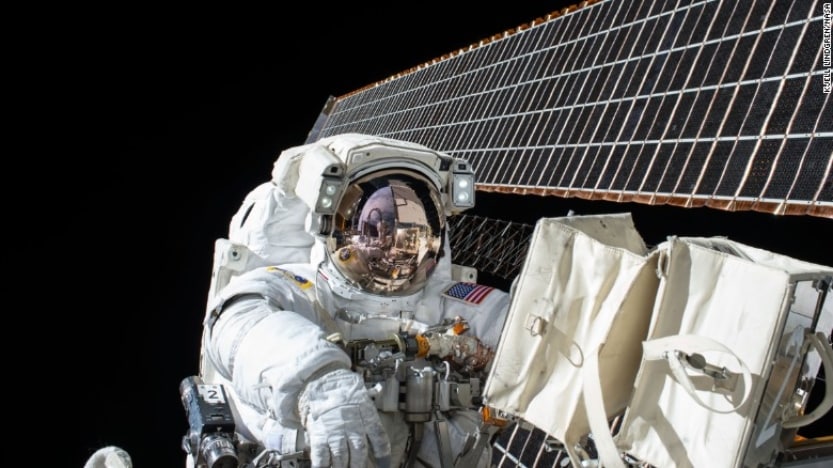A solution to help astronauts with eye troubles in space
Fri 10 Dec 2021
An astronaut’s eyes can change during spaceflights that last six months or more.
That could be a problem for future planned missions.
After decades of research, scientists may have a seemingly unlikely solution: a sleeping bag, developed in conjunction with REI, that pulls fluids away from the brain.
A concern that has emerged regarding astronauts is how their eyes change during long-duration spaceflight, lasting six months or longer, and potential impacts to their eye health over time. Crew members typically spend four to six months on the International Space Station, but future planned missions lasting a year or longer warrant more investigation, according to researchers.
The impact on the health of astronauts’ vision as a result of long-term spaceflight previously was known as visual impairment and intracranial pressure, or VIIP, syndrome. Researchers now refer to ophthalmologic and neurologic findings in astronauts after long-duration spaceflight as spaceflight-associated neuro-ocular syndrome, also known as SANS.
This condition includes swelling of the optic nerve, flattening of the eyeball, and vision impairment, all of which are likely caused when the lack of gravity causes fluids in the body to largely remain in the upper body while astronauts are in space.
Vision problems, including difficulty reading, the need for assistance during experiments, and far-sightedness, have been documented in more than half of the astronauts who spend an average of six months on the space station.
This rush of fluids to the head isn’t an issue for us on Earth because gravity pulls fluids down through the body. If you’ve ever laid down with your head tilting backward, you can just stand up to alleviate the pressure — but that’s not possible in space.
“We don’t know how bad the effects might be on a longer flight, like a two-year Mars operation,” said study author Dr. Benjamin Levine, professor of internal medicine at The University of Texas Southwestern Medical Center and director of the Institute for Exercise and Environmental Medicine, a collaboration between UT Southwestern and Texas Health Presbyterian Hospital Dallas.
“It would be a disaster if astronauts had such severe impairments that they couldn’t see what they’re doing, and it compromised the mission,” said Levine, who has researched the effects of space travel on the human body since the late 1980s.
The best option astronauts have had so far are glasses with adjustable lenses that can correct their vision as it changes in space, but that doesn’t aid with any lasting effects on their eyes or other cardiovascular complications that result from SANS.
“And it’s certainly possible there are other effects of brain pressure we haven’t documented yet,” Levine said. “The astronauts report something they call the ‘space stupids.’ They make more mistakes than they think they should. Whether that has anything to do with the inability to lower the pressure, we don’t know.”
Researchers think a sealed, vacuum-equipped sleeping bag that can suction down body fluid could help solve this zero-gravity issue, according to a new study published Thursday in the journal JAMA Ophthalmology.
During the study, participants were supine, or lying on their backs, for 72 straight hours, which created enough pressure to alter the shape of the eyeball. However, for eight hours each night, their lower bodies were placed in the specially designed sleeping bag, which pulled body fluids down away from the head.
These eight-hour treatments were enough to prevent the eyeball from changing shape.
This latest study is one of many conducted by researchers at The University of Texas Southwestern Medical School to better understand SANS and the intracranial pressure that causes it. In 2015, Levine recruited cancer survivors who still had ports in their heads for receiving chemotherapy for a study because the ports allowed unique access to directly measure pressure in the brain.
The volunteers went on zero-gravity airplane flights passing through Earth’s upper atmosphere, and their brain pressure was measured using the ports, called Ommaya reservoirs, during the flight.
“It was hard. But NASA is awesome, so, heck yeah, I was going to jump at the chance to help. … I did it for the astronauts,” said Wendy Hancock, a leukemia survivor who participated in one of the flights. Hancock recovered from an aggressive form of leukemia and still had the port when she learned that Levine was looking for study participants. Although joining the study required her to revisit some unpleasant experiences from when she had cancer, like having a peripherally inserted central catheter, or PICC line, and providing access to her port, she was eager to participate.
“You’ve got all this stuff strapped on you, and these doctors were literally floating around me, measuring my eye, and that was a little jarring. Eventually, they let me kind of be on my own and sort of float around and that was awesome. It was like swimming,” Hancock said.
The results of this study were published in 2017, which showed that brain pressure in a supine person on Earth is actually greater than someone in space, which helped lead to the design of the sleeping bag.
Armed with this insight, Levine and his team worked with REI to design a sleeping bag that could unload pressure to the brain on a nightly basis.
Shaped slightly like a spacecraft capsule, the bag has a solid frame and fits from the waist down. About a dozen people volunteered to test the sleeping bag, which had flexible structures like a tent. It also included a lazy Susan-like interface to help volunteers rotate if they wanted to turn on their side.
“Our study took advantage of the fact that astronauts have to sleep, and they sleep in the sleeping bags and so we worked with REI to come up with a collapsible sleeping bag that someone can actually spend the whole night in. And what we showed is when we induce lower body suction, intracranial pressure goes down,” Levine said.
Feedback provided by the participants largely focused on how to make the sleeping bag more comfortable.
Currently, there is nothing like this on the space station, but it could be used to design devices that help future astronauts.
The Russian side of the space station includes a Chibis suit, which basically acts as vacuum-sealed pants, but it’s only something cosmonauts use shortly before returning to Earth to reintroduce gravity. The suit is bulky and uncomfortable with restrictive straps — and not conducive for sleeping.
Now, researchers want to focus on the ideal amount of time astronauts would need to spend in the sleeping bag. But it’s a big step forward in tackling a long-standing problem.
“This is perhaps one of the most mission-critical medical issues that has been discovered in the last decade for the space program. I’m thankful for the volunteers who are helping us understand, and hopefully, fix the problem,” Levine said.
Source: Agencies

 Apr 18 2024
Apr 18 2024













